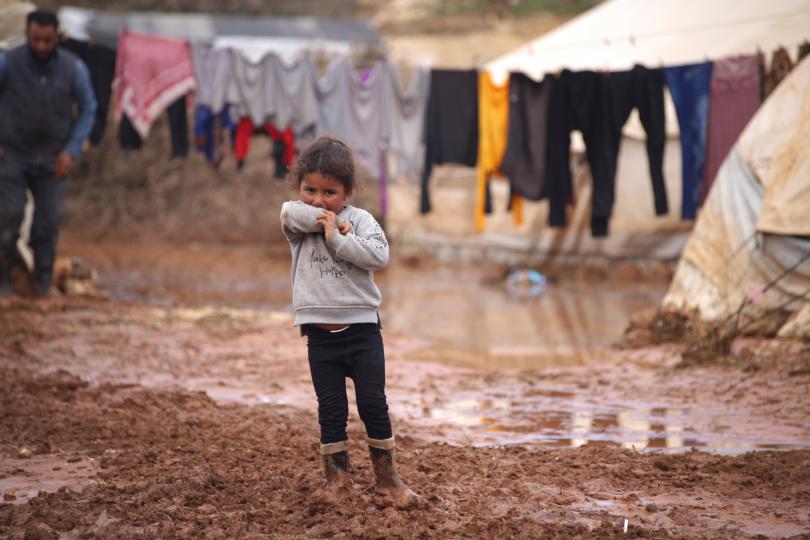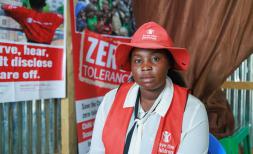9 crises you mustn't forget about in 2024

Tamara, 13, looks outside the window of her house in Taiz, Yemen where she was severely injured by a landmine explosion months before. Photo: Al-Baraa Mansoor / Save the Children.
Violent conflict, extreme climate events, deadly diseases and global economic shocks are devastating children’s lives and threatening their futures. Today, more people are forcibly displaced globally than at any other time since the beginning of the century.
Nearly 300 million people will need urgent humanitarian support in 2024. That’s 1 in 27 people. Among them, a whole generation of children.
As new emergencies occur, some crises can slide out of the headlines. But Save the Children will still be there, working to provide the things you can’t put in a bag: security, education, shelter, health, protection.
Here are 8 crises around the world we shouldn't forget about.
{cta | By giving to Save the Children today, you can help <span class="text-primary">protect a child’s life and future</span>. | https://donate.savethechildren.org/en/donate/what-would-you-save/ | Donate now
DEMOCRATIC REPUBLIC OF THE CONGO

Liliane, 13, in a displacement camp in the Democratic Republic of the Congo where she now lives after fleeing conflict in her hometown. Photo: Hugh Kinsella Cunningham / Save the Children.
Ongoing conflicts in the DRC are turning children’s lives upside down, uprooting millions from their homes, destroying children’s schools, play areas and hospitals and exacerbating hunger and poverty. Families have lost their livelihoods and homes, and children face violence, harm and abuse, with limited access to medical care or education.
The country is also suffering the impacts of the climate crisis with more frequent and severe droughts and flooding destroying homes, displacing families, devastating crops and increasing the risk of disease outbreaks.
READ MORE: What's happening in the Democratic Republic of the Congo?
MYANMAR

Nan Nan, 10, and her 29-year-old mother, Thu Thu, going for a walk in a camp for Internally Displaced Persons in Myanmar. Photo: Save the Children Myanmar.
Humanitarian needs in Myanmar continue to grow as a result of the combined effects of the conflict, a deep economic crisis, and soaring inflation.
This year, one-third of the population will need humanitarian assistance, including six million children.
The impact of the socioeconomic crisis is pushing families to take negative coping measures. Pulling children out of school to work, child labour, early marriage, and even giving children up in exchange for money, are some of the tragic lengths that families are going to, to provide for their children.
Donate to protect children's lives and futures
SUDAN

A double displaced mother holds bullets at an Internally Displaced People's (IDP) gathering point that was burnt down amid fighting in West Darfur. Photo: Mohamed Khalil / Save the Children.
Sudan is facing its worst-ever humanitarian crisis. The eruption of fighting in the capital city of Sudan in April 2023, combined with pre-existing challenges linked to protracted conflicts, climate disasters, disease outbreaks and economic degradation, have left nearly 25 million people, including some 14 million children in need of humanitarian aid.
Over 6 million people have been uprooted from their homes with some 5 million people displaced internally and over 1 million people fleeing to neighbouring countries.
Sudan now has the highest number of internally displaced people in the world. It is also the most significant child displacement crisis in the world, with a recorded 3 million children uprooted from their homes.
READ MORE: The latest on the situation in Sudan.
SYRIA

A girl standing in front of her family tent, through flood water and mud in a camp for internally displaced people in Idlib, Syria. Photo: Hurras Network / Save the Children.
Nearly 13 years of conflict, a deepening economic crisis and the lasting impacts of the earthquakes are devastating the lives of a generation of young people.
In 2024, 16.7 million people will need support - the highest number since the beginning of the crisis- 45% of them children.
A year after the devastating earthquakes, families are still trying to piece their lives back together amid a complex and multi-layered crisis. Children across northern Syria are once again facing huge risks to their physical and mental health following escalations in violence since October. The latest escalations have caused more deaths and injuries and forced hundreds of thousands from their homes.
READ MORE: Türkiye and Syria earthquake: how you can help.
HAITI

Save the Children's Infant and Young Child Feeding Program Advisor Rose Nalda examines the degree of malnutrition of beneficiary Withmaly, 3, in Haiti. Photo: Reginald Louissaint Junior / Save the Children.
A deadly combination of escalating violence, worsening political and economic turmoil, widespread poverty, growing food insecurity and a cholera outbreak in Haiti has left nearly 3 million children in need of humanitarian assistance.
The compounded effects of gang violence, violent civil unrest, roadblocks and increased cases of kidnappings have exacerbated gender-based violence and child protection risks, including the recruitment of children into armed gangs.
Donate to protect children's lives and futures
YEMEN

A child in Yemen paint a flower mural on the walls of a destroyed school as part of the Flowers for Children campaign. Photo: Albaraa Mansoor / Save the Children.
Nine years of war in Yemen have left more than 18 million people – over half of the population – in desperate need of food, water, and life-saving assistance. Millions of Yemenis face widespread displacement, food insecurity and limited access to basic services.
Children have been killed and maimed, uprooted from their homes and seen their schools and hospitals destroyed.
READ MORE: How we support children when a disaster strikes.
THE SAHEL

Issouf, aged 7, his mother Sandrine* and relatives outside their home in Yatenga province, Burkina Faso. Adrien Bitibaly / Save the Children
The Central Sahel region of Africa, which includes Burkina Faso, Mali and Niger, is home to some of the world's most challenged communities facing an unprecedented humanitarian crisis.
An already highly conflictive region has become even more unstable due to the impact of the climate crisis. Droughts have altered the structure of the economy, leading to social changes and coping strategies fuelling conflict, because of access to water or land.
As a result, 10.8 million people need humanitarian aid, and there are about 3 million IDPs, with 2,1 million in Burkina Faso alone, becoming one of the world's fastest-growing displacement crises.
- 70 percent of population movements in the Sahel are linked to conflict: security incidents, attacks and kidnappings are a daily reality for millions of civilians and humanitarian workers in the field.
As with most conflicts, children are the ones being affected the most. They account for more than 50% of displaced people in the region and 1 in 3 children have been taken out of primary school due to deteriorating security.
Donate to protect children's lives and futures
AFGHANISTAN

Jawid (4) stands in front of rubble in the wake of earthquakes in Afghanistan. Photo: Atabek Khadim / Save the Children.
More than two years since the Taliban regained control in Afghanistan, conditions for children and their families remain catastrophic.
A perfect storm of climate disasters, a severe economic crisis and the collapse of essential services have led to one of the worst food crises ever recorded. Some 23 million people need humanitarian assistance this year. 1 in 3 people are facing extreme hunger and 41% of children under 5 are currently facing acute malnutrition.
Over 95% of families are not able to meet all of their basic needs, such as food and shelter.
The crisis is taking its toll on mental health and well-being, with 26% of girls and 16% of boys showing signs of depression.
READ MORE: Afghanistan: a crisis on top of a crisis.
COX'S BAZAR

The aftermath of a major fire in Camp 5 in Cox's Bazar, Bangladesh, that left at least 7,000 Rohingya refugees without shelter. Photo: Monalisha Mollick Mona / Save the Children.
Six years since Rohingya refugees fled from violence in Myanmar to Bangladesh, conditions in the camps for refugees are getting worse rather than better.
Living in squalid and overcrowded conditions, almost 1 million Rohingya refugees remain almost entirely dependent on humanitarian aid to survive. Unable to work or access formal education opportunities, Rohingya refugees remain stateless and unprotected.
Three in four children are out of school, and living conditions in the camps mean there is a major risk of disease outbreaks, including diarrheal diseases and measles.
Rohingya children in Cox's Bazar are now eating 20% less than they were last year due to food ration cuts.
READ MORE: Rohingya crisis: how to help.
When a crisis strikes, Save the Children is there
We’re there before, during, and after a crisis. We help communities prepare for the next disaster – because it’s not a matter of if, but when.
We’re there when disaster strikes, to provide the urgent supplies families need to survive.
And we deliver what can’t be packed in a bag – what children need to recover and rebuild their futures.
Donate now to help us prepare better, respond faster and protect longer when the next disaster strikes. Please donate what you can so we can provide children with the things you can’t fit in a bag.
Donate to protect children's lives and futures







